by Prof. Huan Nguyen, Director, and Dr. Ramona Trestian, LDTRC
- with thanks to our external collaborators, Dr. Duc To, Viavi Solutions and Dr. Mallik Tatipamula, CTO, Ericsson Silicon Valley


Although many countries have started the initial phase of rolling out 5G, it is still in its infancy with researchers from both academia and industry facing the challenges of developing to its full potential. With the support of Artificial Intelligence (AI), development of digital transformation through the notion of a ‘Digital Twin’ has been taking off in many industries such as smart manufacturing, oil & gas, constructions, bio-engineering, and automotive. However, Digital Twins remain relatively new for 5G networks, despite the obvious potential in helping develop and deploy the complex 5G environment. At London Digital Twin Research Centre, we investigate these topics and discover how Digital Twin could be a powerful tool to fulfil the potentials of 5G networks and beyond. Some market challenges with open questions exist: (1) how to speed up the deployment of new (but complex) 5G technologies? (2) how to provide flexible testbed facilities with high availability? and (3) who is willing to invest in the expensive 5G deployment with uncertain returns.
Our findings and discussions are to appear soon in IEEE Communications Magazine.

There is demand for a virtual solution that could create a digital model to replicate as accurately as possible the 5G ecosystem and help tackle all the above obstacles to satisfy the 5G needs. The DT has the potential to assess the performance, predict the impact of the environment change and optimize the 5G network processes and decision-making accordingly. In these contexts, a 5G DT can act as a highly interactive 5G emulator, with the immediate use cases in 5G automotive, radio and channel emulation, testing and continuous validation.
5G offers great potential for new business cases. The requirements of various services create many constraints for the network deployment. In the context of each business case, each provider requires different objectives which can be conflicting. Thus, deploying an optimized 5G network in one go is an impossible task due to its complexity, including the lack of data, e.g., user behaviours and channel characteristics, to optimize the network. The unavailability of a sufficient amount of accurate data prior to the deployment plan becomes a bottleneck. The 5G DT architecture could minimize the human involvement in the design and validation of the physical network, which brings two-fold benefits: lower labour costs and less human errors. As such, one example is the recently proposed open architecture RAN of 5G (O-RAN).
[Updated]: Full version of the work is now available here.


